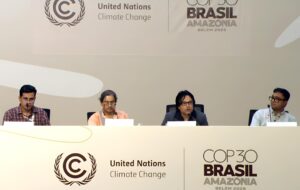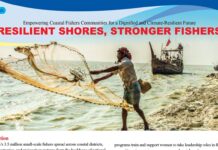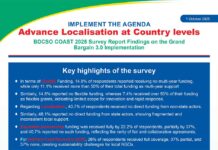Belem Climate Conference [CoP-30]
Developed countries have shirked their responsibilities as always
Deal without Phase-out of Fossil Fuel Roadmap and Low-Balled Adaptation Finance
- Introductory
The global climate conference [CoP-30] was scheduled from 10-21 November, but was extended by one day [22 November] due to a stark divide in negotiations. Finally, COP30 has reached a deal without a roadmap for phasing out fossil fuels, raising doubts over global efforts to limit warming to 1.5°C. The conference did not provide any guarantee of receiving funds for the affected countries. Despite more than 80 countries calling for a roadmap to phase out fossil fuels, that demand did not make it into the final text. Some of the achievements worth mentioning include the creation of the $6.6 billion Tropical Forest Forever Facility (TFFF) fund. The draft text mentions a tripling of adaptation funding by 2030, and the first phase of the Fund for Loss and Damage [FRLD] has been called for proposals. COP-30 ended amid discussions, criticism, anger, influence of Petro state/ developed countries/ lobbyists, and protests by indigenous peoples over the course of two weeks.
2. COAST Participation and demands at CoP-30
COAST participated in the Belém Climate Summit and organized a press conference, a side event, and a photo exhibition and participated in various events of various networks The specific demands were:
(A) Ambitious NDC-3.0: To enhance NDC 3.0 with ambitious, transformative, and 1.5-degree Celsius temperature-aligned mitigation goals, establish a definitive timeline for phasing out fossil fuels, leading to their complete elimination, and align with the submitted NDC-3. It should also make a decisive decision to immediately phase out all coal-based power plants and fossil fuel subsidies.
(B) Trillion dollars through public finance: A clear, fair, and time-bound pathway to implement the New Collective Quantified Goal (NCQG) decision, and developed countries must address the trillion-dollar annual climate finance goal by 2035, through public finance, ensure adequacy, transparency, and while fully considering the needs and special circumstances of LDCs & MVCs.
(C) Article 9.1 as a standalone agenda: To embed Article 9.1 of the Paris Agreement as a standalone agenda item, reaffirming the financial commitment as a legal obligation and ensuring its transparent & accountable implementation.
(D) GGA indicator & triple adaptation finance: A clear and credible roadmap to finalize measurable and meaningful indicators for the Global Goal on Adaptation (GGA). These indicators must go beyond vague commitments and drive real progress in enhancing adaptive capacity, strengthening resilience, and reducing climate vulnerability, and triple adaptation finance by 2030 as part of an ambitious NCQG.
(E) Rapid, direct & simplified access for FRLD: Rapid, direct, and simplified access to the Fund for Responding to Loss and Damage (FRLD), and include the NCQG Roadmap as a sub-goal on L&D finance, with clear options for the provision of public, grant-based resources to developing countries.
- Negotiations Key Outcomes of CoP-30
Negotiations focused on three topics within the mutirão decision: Nationally Determined Contributions (NDCs) response, adaptation finance, and trade. COP30 was sharp in focus on ramping up climate finance for hard-hit developing nations and tackling deforestation.
(A) Launch of the Tropical Forest Forever Facility (TFFF): Major progress was made in climate finance through the TFFF, led by Brazil. This innovative public/ private fund aims to provide long-term funding for tropical forest conservation. The amount of funding has already reached about $6.5 billion with pledges from countries including Norway, Indonesia, France, Colombia, the Netherlands, Portugal, and Brazil. Brazil expects the amount of funding to reach $10 billion by November next year. The goal of this fund is to provide direct support of $4 for every hectare of tropical forest protected by developing countries.
(B) Calls for the first phase of the Loss and Damage Fund: Launch of the L&D Fund and the approval of full operational rules. The Fund will allow, for the first time that affected countries will be able to apply directly, receive rapid assistance, and formally assess non-economic losses. Initially, climate-affected countries will be able to submit their projects to receive US$5–20 million per year from the Loss and Damage Fund against an allocation of more than $250 million. The procedures include a board structure, secretariat, decision-making process, and the Barbados Implementation Methodology (BIM). The fund currently holds US$756 million, with no major new pledges, leaving much of the burden on vulnerable nations.

(C) Triple Adaptation Finance: The summit agreed to double climate adaptation finance by 2025, triple global flows to US$120 billion annually by 2035, but does not specify where the money will come from: Rich countries, development banks, or the private sector are all possible sources.
(D) Global Goal on Adaptation (GGA): CoP-30 has finalized a comprehensive set of 59 voluntary, non-prescriptive indicators to track progress under the Global Goal on Adaptation. These indicators span all sectors, including water, food, health, ecosystems, infrastructure, and livelihoods, and integrate cross-cutting issues such as finance, technology, and capacity-building.
(E) Just transition mechanism: Parties approved a just transition mechanism that puts people and equity at the center of the fight against climate change. The initiative aims to enhance international cooperation, technical assistance, capacity-building, and knowledge-sharing, and enable equitable, inclusive, just transitions.
(F) Belém Declaration: Which was ratified by 44 countries. It states that climate change is not only a source of environmental, but also social & human inequalities. Special attention will be paid to social protection, crop insurance, and increased livelihood opportunities for smallholder farmers, family farmers, and traditional communities.
- Failures and criticisms [Our analysis]
(A) No Fossil Fuel Phase-out Roadmap: The biggest failure of COP30 was the omission of any direct mention or a clear roadmap for the transition away from fossil fuels in the final text, despite strong support from over 80 countries, including the EU. The current language was criticized for being too vague, a step back from the commitment to “transition away” at COP28. It’s a grave injustice that two years later, historical polluters are still blocking progress in ending the era of fossil fuels by withholding commitment to pay up their climate debt to the Global South on all fronts.
(B) Inadequate Climate Finance Commitments: “call” to triple funding for adaptation on previous commitments made at COP26 in 2021, which were to double adaptation
funding to $40 billion by 2025. The initial proposed date for the disbursement of $120 billion per year has also been pushed back from 2030 to 2035. The UNEP estimates that the need for adaptation funding in developing countries will be between $310 billion and $365 billion per year by 2035, 12 to 14 times higher than current funding flows.
(C) Missed NDC Deadlines and Ambition Gap: Many major emitters, including the EU & India, missed the deadline to submit their new 2035 NDC-03 with increased ambition. This further widened the “ambition gap” for keeping global warming within the 1.5°C limit.
(D) Lack of Accountability: The text lacked accountability mechanisms for rich countries to meet their financial obligations and make real emissions cuts, instead relying on potentially problematic approaches like carbon markets.
(E) GGA Indicators not align with LLA principles: Unfortunately, COP 30 failed to deliver a coherent outcome on indicators for the Global Goal on Adaptation (GGA). There is a lack of quantifiable, outcome-based targets and insufficient inclusion of specific metrics for means of implementation (finance, capacity building, technology transfer), among the limitations- (a) absence of concrete, measurable, and time-bound global targets, similar to the 1.5°C global warming limit, (b) insufficient Focus on Finance and Implementation Support, (c) the proposed global indicators do not align well with the principles of Locally-Led Adaptation (LLA). Only about 35% of the proposed GGA indicators directly align with LLA principles.
- Closing Remarks:
Despite many developed countries claiming to uphold the 1.5 °C climate goal, their hypocrisy was on full display as they refused to follow through on necessary actions and funding to transform those words into reality. The adaptation finance result falls short. While the outcome includes a commitment to triple adaptation finance, it lacks a defined baseline, does not clarify who will pay, and delays delivery to 2035, far too late for those on the frontlines. Beginning of CoP-30, hope was promised but not delivered; fossil fuels remain unaddressed, and political will is absent. Developed nations continue to escape responsibility, pushing loans over grants and refusing clear commitments for a fossil fuel phase-out.
Our struggle, campaign, and advocacy will continue until establish a clear roadmap for phasing out fossil fuels, aligning with the 1.5-degree Celsius temperature mitigation goals, and meeting the trillion-dollar demand for the New Comprehensive Climate Finance Goal (NCQG). We expect a clear, fair, and time-bound pathway to implement the NCQG decision, and developed countries must address the trillion-dollar annual climate finance goal by 2035 through public finance. This should ensure adequacy, transparency, and predictability, while fully considering the needs and special circumstances of LDCs and MVCs.





![Promoting Climate Adaptive Income Generating Techniques [CAIGT] for Sustainable Coastal Livelihood](https://coastbd.net/wp-content/uploads/2025/11/Index-photo-218x150.jpg)

